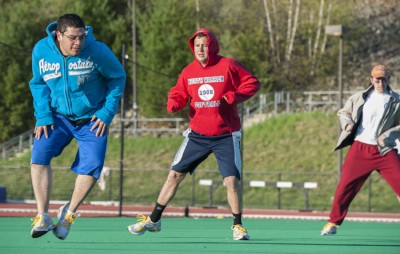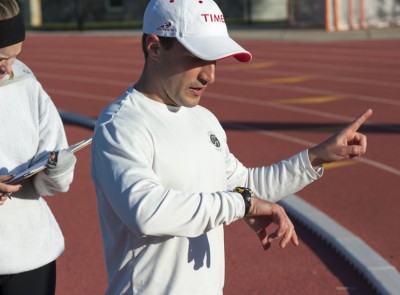
Wearing a heart rate monitor while running, bicycling or performing other aerobic exercise helps ensure a person reaches and maintains his or her prescribed intensity level—an essential aspect of working out that not everyone understands.
Use of a wristwatch-style or similar type monitor is one method of tracking exercise intensity during a workout recommended by the American College of Sports Medicine (ACSM). However, for his doctoral research project, Neag School of Education kinesiology student Evan Johnson wanted to know whether people exercising without a monitor could feel or perceive when their bodies reached a prescribed level, as this method has been suggested as a surrogate for heart rate monitoring in the past. The results surprised him.
“The study followed two groups of beginning runners: one whose members used a Timex heart rate monitor, and one whose didn’t. My hypothesis,” said Johnson, “was that the group without the monitors would exercise at a significantly lower rate and not be able to accurately tell when their bodies reached the prescribed exertion levels. What occurred, however, was that on average, both groups with and without monitors recognized when their bodies reached high-intensity workout levels, but only those with monitors were able to accurately identify when they reached low-intensity levels. Those without monitors who were attempting to exercise at a low-intensity were off by as much as 60 heartbeats per minute above or below the rate I prescribed.”
Based on age, overall health and variables like medication and environmental temperature, an adult’s maximum heart rate (MHR) level is generally calculated by subtracting his or her age from 220, according to the ACSM. For ideal exercise results, a person then exercises at their target heart rate, which is a percentage of the maximum rate. Ideally determined by a physician or health expert like Johnson, ACSM-recommend target heart rate levels for people in overall good health are:
- 50-65 percent of MHR for a beginning exerciser
- 60-75 percent of MHR for an intermediate exerciser
- 70-85 percent of MHR for an experienced exerciser
“Despite the recommendation of the American College of Sports Medicine and other experts, many do not use heart rate monitors,” Johnson said, “but they’re an easy way to ensure a person is reaching the prescribed level that is safe and that will bring about the most beneficial health results.”

Results of Johnson’s six-week study included both losses and gains. Overseen by Johnson, the 40 men who followed the ACSM’s recommended 150-270 minutes per week of moderate- to vigorous-intensity exercise lost an average of 3 pounds and 0.6 percent of body fat. They also increased the distance they were able to run in 12 minutes an average of 780 feet—the equivalent of a little more than half a lap on a standard outdoor track. The majority also decreasedtheir running pace by one minute per mile during the same 12 minute running test.
Before the study, none of the participants exercised more than 90 minutes a week. Several didn’t previously exercise at all, and all were classified as overweight, based on the National Institutes of Health’s body mass index calculator.
“Also significant is that participants saw an average 10 percent improvement in maximal oxygen consumption, which is a measurement of the amount of oxygen a person is able to use during aerobic exercise,” Johnson explained. “This number is especially important for competitive athletes, because the more oxygen you can use, the more work can be completed for a given unit of time. It’s also important for non-athletes, as higher oxygen levels are related to a more efficient cardiovascular system and better overall heath.”
However, most people don’t realize the important role of intensity in a workout.
“To achieve the weight loss and disease prevention benefits most people desire, reaching appropriate intensity levels is necessary,” Johnson said. “Some people with medical conditions should limit themselves to lower-intensity workouts. And our data shows that when a heart rate monitor was utilized, participants were able to more accurately replicate prescribed intensities when they were lower. Therefore, the only way to know for sure that you’re not over- or under-doing it is by using a heart monitor.”
“One of the things that excites me most about this study is that everyone got healthier and fitter,” Johnson continued, adding that only about 20 percent of adults perform the kind of regular exercise a body needs. “Anytime you get evidence that a person’s health can be significantly improved in just six weeks it is a great thing. It also gives us stepping stones for future studies.”
According to Douglas Casa, UConn Athletic Training Education director and a kinesiology professor within the Neag School, Johnson’s study helps illustrate the Kinesiology Department’s dedication to advancing overall health and fitness. UConn’s kinesiology doctoral program is ranked No. 1 in the country by the National Academy of Kinesiology.
Conducted through UConn’s Korey Stringer Institute, Johnson’s research was part of a three-year, five-part study launched through a UConn-Timex partnership. Similarly committed to improving public health, the sports performance monitor and timepiece manufacturer joined forces with UConn to investigate links between health, performance improvements and monitoring devices.
While Johnson’s part focused on monitor use by those in the general public, others have focused on the roles GPS units, calorie trackers and similar devices can have on elite athletes, such as those who compete in the Ironman Triathlon World Championships and play for professional sports teams like the New York Giants.
Recently graduated, Johnson has taken the knowledge and expertise he acquired from the Neag School to the University of Arkansas, where he is working as a post-doctoral fellow studying the relationship between fluid intake and physical health. Yet he’s not fully leaving the Neag School behind. Over the next several months, Johnson and Casa will be fine-tuning at least one journal article about the heart rate monitor study, which they hope to publish in a scientific, peer-reviewed journal.
“The message people need is to not just exercise, but to achieve their prescribed dose which includes adequate intensity,” Johnson said. “Before exercising, a person should talk with a health expert to get that prescription. Once the level is known, heart rate monitors can be a great tool to ensure that maximum exercise benefits are achieved.”
 Facebook
Facebook
 Twitter
Twitter
 LinkedIn
LinkedIn
